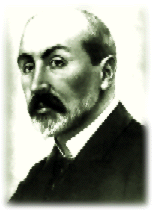|
LORÁND EÖTVÖS (1848 - 1919) |
 |
Loránd Eötvös was born in Buda, and became a physicist. During his university years in Pest his master was Ányos Jedlik, and studied under Kirchhoff, Bunsen and Helmholz in Heidelberg. He also took his Ph. D. degree there in 1870. His theoretical work was significant. He was deeply engaged in studying capillary action and gravity. He created the so-called Eötvös Rule, which states that there is a relation between the surface tension of pure liquids and temperature changes. His law regarding changes in weights of bodies in motion has been called the Eötvös-effect. He established the identity of gravitational and inert masses, on which Einstein based his theory of relativity. In 1888 he devised the Eötvös-pendulum, which he did not patent due to his love of science. From 1873 he was a member of the Hungarian Academy of Sciences; subsequently he was the president of the Academy between 1889 and 1905. From 1871 he lectured at the Budapest University of Sciences, and later he became the rector of the University. From 1878 he led the Institute of Experimental Physics.
In 1894 and 1895 he filled a governmental post as Minister of Religion and Education. In 1895 he established the Eötvös College in memory of his father.
Representatives of the international scientific world regard him even today as the master of classical physics. In 1909 he received the Benecke prize in Göttinga for his gravity measurements. Two years later the Royal Prussian Academy of Science, the Jagello University of Krakow and the Norwegian Royal University conferred the title of honorary doctor upon him.
Torsion balance (1906)
While researching the changes of gravitation, Loránd Eötvös invented the torsion balance. Its first version was completed in 1891 and was a human-sized measuring device.
The operation was based on the principle that the forces of attraction exerted by various underground materials on the two masses suspended on a lever of second order were different. One weight was suspended 20 cm lower than the other. They were made of gold or platinum, because high-density materials needed to be used for measurements.
The degree of torsion was indicated by a needle moving in front of a dial. In the beginning, the device was protected by a single-walled case; its thickness was eventually tripled to prevent the balance from being affected by air movements, temperature changes and electric effects caused by moving metal particles during the measurements.
At its inception, the application of the torsion balance was widespread. It was used in oil exploration until the mid-1930s. For a short period it was displaced by modern instruments, but since 1950 it has regained its importance in geophysical exploration. The first practical result of the Eötvös-pendulum was obtained near Kis-Sármás, county of Kolozs where a rich source of natural gas was discovered with the aid of this instrument.
As a result of a number of improvements, the original measuring time of 5 hours has been reduced to 40 minutes.

